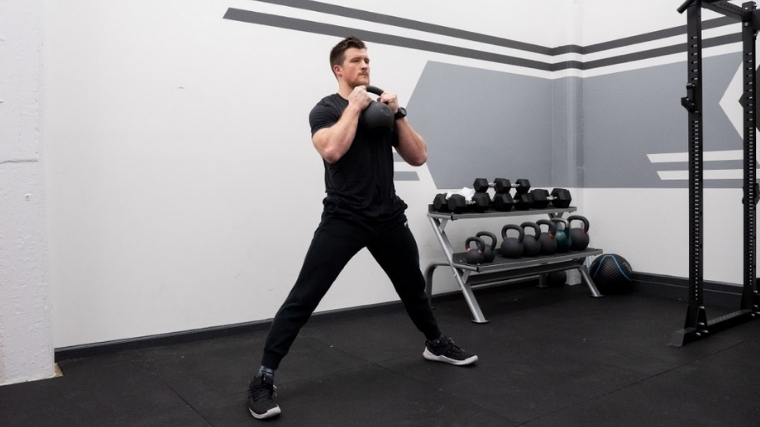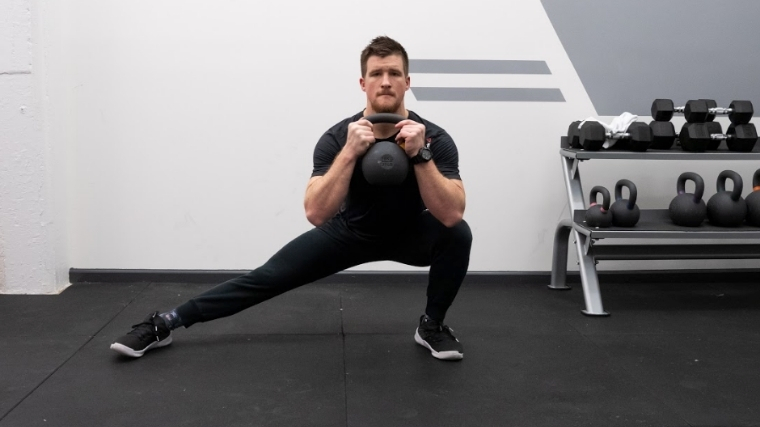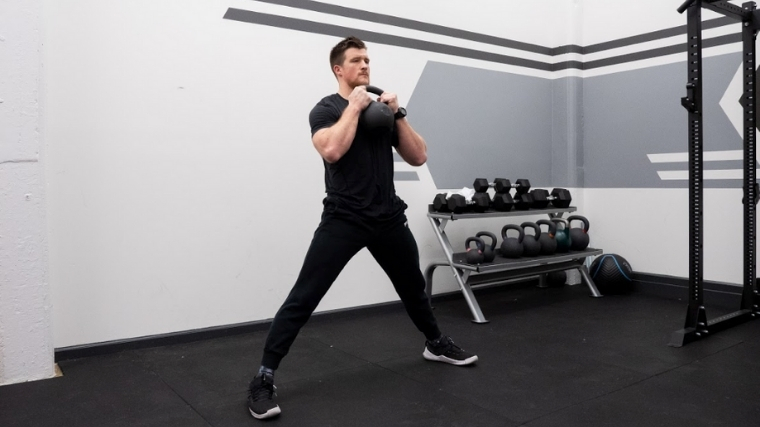The Cossack squat is a single-leg squat variation that develops mobility, flexibility, and strength in the frontal plane. Cossack squats can benefit beginners and advanced lifters, but they are challenging and often require modifications to be done effectively when you first start with them.
In this article, we cover everything you need to know about the Cossack squat, including:
- How to Do the Cossack Squat
- Benefits of the Cossack Squat
- Muscles Worked By the Cossack Squat
- Who Should Do the Cossack Squat
- Cossack Squat Sets, Reps, and Programming Recommendations
- Cossack Squat Variations
- Cossack Squat Alternatives
- Frequently Asked Questions
How to Do the Cossack Squat Step by Step
A Cossack squat is essentially a deep squat on one leg and one-half of a split on the other. The squatting leg is challenged by reaching full flexion at the hip, knee, and ankle, while the hamstrings and adductors in the other leg are put under significant amounts of stretch.
Each leg supports the other through a range of motion it may not achieve in the bilateral equivalent deep squat or splits. Breaking down the movement step-by-step can help you get started safely on the right path.
Step 1 – Find Your Stance
Set up with your feet nice and wide, standing tall. Adjust your stance based on what feels comfortable for you and allows you to achieve the greatest end range of motion without movement compensations.
Holding a dumbbell or kettlebell at the chest in a goblet hold provides a useful counterbalance that most lifters find makes the exercise easier than working with bodyweight alone, provided that the loads are not too heavy. The counterweight can help you stay upright, lean your weight back and get through a full range through the hip, knee, and ankle without falling backward. If you prefer to work without weight, you can reach your arms out in front of you to provide a similar counterbalance element.
Form Tip: Having heels approximately four feet apart is a good reference point. Your toes can point straight ahead or slightly outwards.
Step 2 – Shift your Weight and Sit
Squat down to a full deep squat on one side, keeping both heels on the ground. In the bottom position, the squatting leg is fully flexed at the ankle, the knee is out over the toe, the other leg is straight, and the torso is upright.
As you squat down, externally rotate the straight leg so that the toes come up off the ground while the heel stays firmly planted. Rotating the foot shifts some of the deep stretch from the adductors to the hamstrings. You can experiment with how much foot turnout you use based on what feels most comfortable and what allows you to hit the lowest depth.
Step 3 – Stand Up
Once you’ve reached depth, press into the ground through the bent leg to bring yourself back up to the starting position, standing tall in your wide stance. Rotate the straight leg back to neutral so that the toes come back on the ground. Repeat steps one through four on the opposite side.
Benefits of the Cossack Squat
It’s a mistake to view the Cossack squat as just a bodyweight or flexibility exercise. Building a strong Cossack squat develops neuromuscular control and mobility in the frontal plane. Don’t be surprised if it improves your max strength in the squat and deadlift by reducing asymmetry and increasing eccentric strength in the lower body.
Restores or Improve Range of Motion
The Cossack squat develops hip, knee, and ankle mobility and flexibility through the hamstrings and adductors. Having a limited range of motion can impede squat strength and also leave you vulnerable to injuries such as hamstring or groin pulls. Doing Cossack squats can help improve range of motion through the lower body and unlock the associated performance benefits.
Builds Resilient Joints and Soft Tissues
Getting into a full-depth Cossack squat will promote resilience and health in both joints and soft tissues. In the Cossack squat, the bent leg reaches a full depth at both the ankle, knee, and hip, and the straight leg undergoes a significant degree of stretch in the hamstrings and adductors. Being able to get in and out of these positions safely and with control promotes joint health and reduces the risk of soft tissue injuries such as a groin or hamstring pull.
Improves Frontal Plane Movement Ability
Human movement takes place in three planes: sagittal, frontal, and transverse planes. Most traditional strength training exercises are done in the sagittal plane. However, neglecting movement in the frontal plane increases injury risk and leaves performance potential untapped. Therefore, building strength and mobility in the frontal plane is important for both athletes and the general population.
Better Squats
If you’re having trouble hitting depth in your squats, working on Cossack squats can help get you there. The deep flexion in the knees, hips, and ankles achieved in the bottom position of the Cossack squat exceeds that required for a full-range squat. In addition, single-leg exercises help to correct or reduce asymmetries between the right and left sides, which can reduce wear and tear, increase range of motion and increase strength output.
[Related: The Best Pre-Workout Supplements for Strength, Cardio, and More]
Muscles Worked by the Cossack Squat
The Cossack squat primarily targets the knee and hip extensors on the leg that performs the deep squat and eccentrically loads the hamstrings and adductors on the straight leg. Here is a summary of the main muscles worked by the Cossack squat.
Adductors
The adductors are trained eccentrically through the lowering phase of the Cossack squat. Doing Cossack squats will increase eccentric strength, muscle fascicle length, and flexibility in the adductors. The adductors are incredibly important and often underdeveloped. The training effect on the adductors is reason enough to include the Cossack squat in your program.
Hamstrings
The hamstrings are trained similarly to the adductors — they are being lengthened through the downward phase of the movement. Rotating the foot of the straight leg shifts the emphasis of the stretch from the adductor to the hamstring. The more your foot is turned up, the greater the stretch is in the hamstrings.
Quadriceps
The deep knee bend of the squatting leg in the Cossack puts the knee extensors or quadriceps in a fully flexed position. Therefore, the quads must work to pull you out of the deep squat as you push down into the ground to return to the starting position.
Glutes
The glutes work to extend the hip out of the fully flexed position at the deep squat’s bottom.
Who Should Do the Cossack Squat
The Cossack squat is a great movement that different types of athletes can use to increase mobility, injury resilience, and squatting strength. Here’s how specific types of athletes can take advantage of the unique benefits of the Cossack squat.
Strength Athletes
The Cossack squat is beneficial for strength athletes by increasing their range of motion and strengthening the adductors. These benefits combined can improve strength output in primary barbell lifts. Stronger adductors are associated with stronger squats (1). Single-leg strength can reduce the risk of injury and help you train harder for longer, the real key to elite strength.
Sport Athletes
Sports like football, basketball, soccer, and hockey all require moving explosively and changing directions through the frontal plane. Lateral drills such as Heiden jumps develop power in the frontal plane, but one also wants to emphasize neuromuscular control and eccentric strength, both of which are trained in the Cossack squat. The Cossack squat can be used alongside exercises like the Copenhagen plank to help prevent groin pulls for athletes in sports where they are common.
General Population
Human movement takes place in three planes, and everyone needs to move capably in all three. Improved mobility and reduced muscular imbalances are a useful injury prevention strategy that also increases training longevity. Everyone stands to benefit from including the Cossack squat in their program.
Cossack Squat Sets, Reps, and Programming Recommendations
The Cossack squat is an accessory exercise, not a main lift to increase your strength. However, no matter how you program it, the Cossack squat will develop your mobility, neuromuscular control, and reduce imbalances.
Here are some specific programming suggestions for how to build the Cossack squat into your program.
To Warm-Up
The Cossack squat can work well in the latter stages of a warm-up. However, due to the mobility demands of the movement, you’ll perform better if you do some general warm-up exercises before your Cossack squats. Complete one to two sets of five to 10 reps on each side.
As Part of a Conditioning Circuit
A great way for lifters to develop conditioning is to do a circuit of various accessory exercises with little rest in between. For example, perform the Cossack squat with an explosive exercise, a best upper body exercise, and a conditioning activity — like a 10-second sprint on an air bike — into a circuit. Doing Cossack squats in a circuit develops your ability to move while fatigued.
Two to four sets of five to 10 reps each leg work well, depending on the number of rounds of your circuit you are doing.
To Develop Mobility
Do Cossack squats early in a training session after you are warm but before you are too fatigued from your other exercises. If you are doing a light training session or a deload, they could even be the main exercise of your day. Do three to four sets of five 10 reps each leg. Don’t add weight to these, or, if you do, hold a light kettlebell.
Cossack Squat Variations
It takes a lot of practice to do perfect Cossack squats. Most people cannot do a Cossack squat without first developing their range of motion and control.
Below are a few regressed variations of the Cossack squat to help you get started safely with the movement and then some more advanced alternatives for those ready to take their Cossack squats to a new level.
[RELATED: Best Mobility Workouts]
Supported Cossack Squat
Holding onto support like a squat stand or TRX makes the bottom position of the movement more accessible by providing a counterbalance and allowing you to pull yourself up out of the bottom position. The TRX is great because it moves with you.
Having support allows you to lean back and find a deep stretch in the hip without being constrained by limitations in ankle mobility. This is an excellent way to start working on Cossack squats and getting comfortable in the bottom range of the movement.
Landmine Cossack Squat
Working with a landmine can intensify the movement by adding an external load, but it also assists in forming a counterweight, similar to the supported variation described above. In addition, and in contrast to a dumbbell or kettlebell variation, the weight in the landmine variation is anchored and stable.
Foot-Elevated Cossack Squat
Elevating the foot in the Cossack squat reduces the mobility demands and makes it easier to keep the torso upright throughout the movement. This is a useful variation for those with limited ankle mobility. In this variation, you will complete all of your reps on one leg at a time rather than alternating. A six-inch box or step is a good starting point for those doing this variation.
Cossack Squat Alternatives
Once you feel comfortable performing Cossack squats (it may take a while, and that’s ok), try one of these variations.
Back Rack Cossack Squat
Once you are comfortable and capable in the movement, you can pursue additional strength gains by increasing the weight. A back rack Cossack squat is an advanced variation that makes working with heavier weights easier and also provides an additional challenge to your core. However, it may take a long time before exploring this alternative is necessary or appropriate.
Low Switch Cossack Squat
The low switch Cossack squat has you move from side to side rather n the down position than standing upright in between each rep. This applies a greater stretch and mobility demand to maintain the low position, placing the hamstrings and adductors under near-constant tension.
https://youtube.com/watch?v=MklBrkwVE4k
Lateral Squat
A lateral squat or lunge is a simplified version of the Cossack squat that involves the same lateral squatting component but not the same depth. A lateral squat develops some movement ability in the frontal plane without the same flexibility requirements as the Cossack squat.
FAQs
I’m really inflexible. Can I still do Cossack squats?
Indeed, many lifters and athletes won’t have the range of motion required to do Cossack squats right away. Instead, most people will be able to work on a supported version or a lateral squat. Stretching of the adductors and hamstrings and working on ankle mobility concurrently with these movements can get you ready for a proper Cossack squat.
Are Cossack squats effective for building muscle?
Not particularly on their own, but by developing mobility and resilience, you could be more able to train harder for longer in your primary muscle-building exercises.
Where am I supposed to feel Cossack squat
It varies. Most people will primarily feel the intense stretch through the adductors or hamstrings. Others may feel it in the deep squatting leg. Any sensation of a stretch should be strong but comfortable.
I’m really inflexible. Can I still do Cossack squats?
Indeed, many lifters and athletes won’t have the range of motion required to do Cossack squats right away. Instead, most people will be able to work on a supported version or a lateral squat. Stretching of the adductors and hamstrings and working on ankle mobility concurrently with these movements can get you ready for a proper Cossack squat.
Are Cossack squats effective for building muscle?
Not particularly on their own, but by developing mobility and resilience, you could be more able to train harder for longer in your primary muscle-building exercises.
Where am I supposed to feel Cossack squat
It varies. Most people will primarily feel the intense stretch through the adductors or hamstrings. Others may feel it in the deep squatting leg. Any sensation of a stretch should be strong but comfortable.
References
- Kubo K, Ikebukuro T, Yata H. Effects of squat training with different depths on lower limb muscle volumes. Eur J Appl Physiol. 2019 Sep;119(9):1933-1942. doi: 10.1007/s00421-019-04181-y. Epub 2019 Jun 22. PMID: 31230110.


